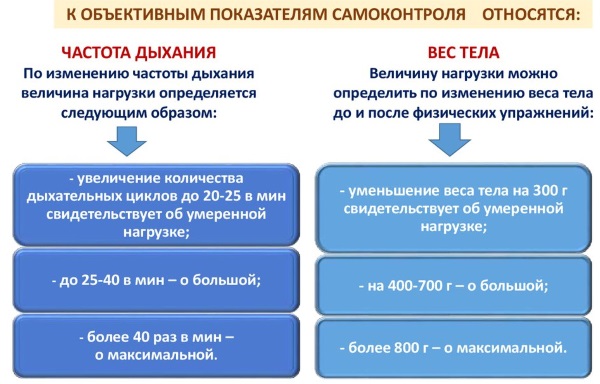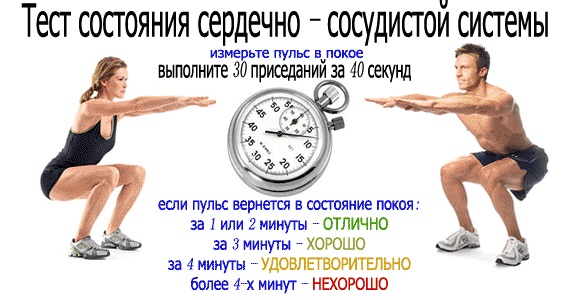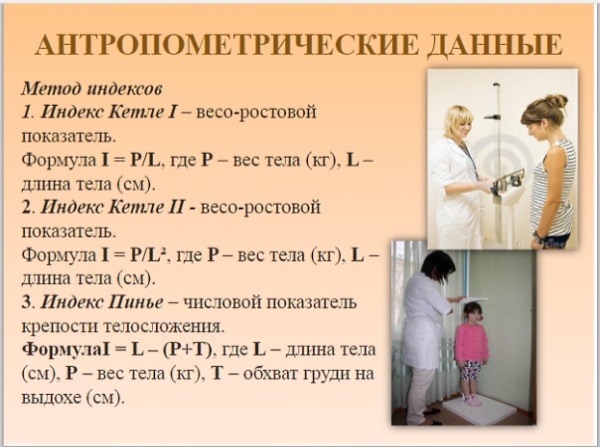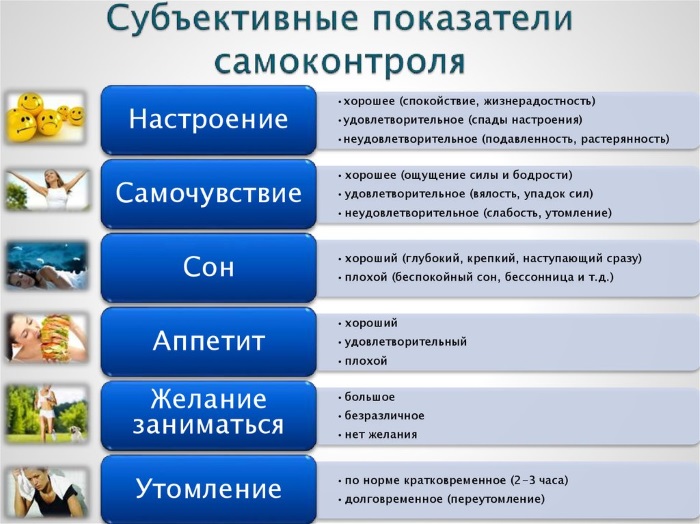Sports activities, like almost any human action, should not be carried out uncontrollably. In this case, the best option is to develop self-control. In a general sense, self-control is the ability of a person to control his behavior, emotions, thoughts, to rationally respond to external stimuli.
Of course, this requires a certain amount of effort, concentration and discipline. When doing physical exercise self-control is one of the main elements that allow you to get maximum benefits and results without harming your health.
It is aimed at ensuring that, regularly observing and taking into account the physiological data and the state of the body, competently optimize sports.
Why do you need
Self-control during physical exercise has the main goal - to minimize possible health risks, using the optimal load for the state of the body, taking into account age-related changes in the load.
The development of skill and competent, as well as disciplined observation of physiological changes in the body and their analysis allows:
- receive objective data on the state of health;
- to establish deviations from the norm;
- take timely measures to eliminate the identified deviations;
- make the necessary changes to the training system;
- increase the effectiveness of sports.
It should be borne in mind that self-control is important not only for athletes, but also for people who decide to play sports on their own. Moreover, in this case, there is often no proper medical supervision and it is not always possible to consult a coach.
The tasks of self-control include:
- obtaining deeper knowledge about the physical development of the body;
- the possibility of an independent primary assessment of psychological and physical preparation for certain physical activities;
- familiarization with the concept of self-control and its methods;
- development of skills for adjusting the load when playing sports.
Self-control allows you to react in a timely manner in cases of adverse effects on the body of physical activities.
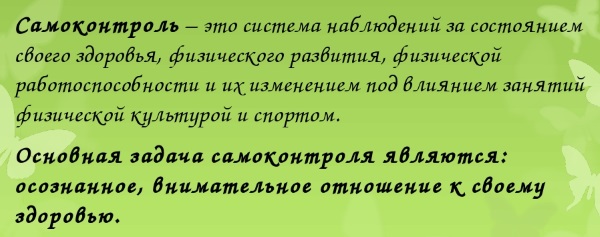
Advantages and disadvantages
Self-control certainly has many benefits. In particular:
- This skill allows a person to become more confident. In turn, this self-confidence inspires respect and increases the trust of other people. The skill of self-control often helps to become more successful in life, not to quit the job started, despite the presence of obstacles, and, accordingly, to achieve the set goals.
- Self-control when engaging in physical exercise allows you to solve the issue of health promotion.Regularly observing the psychophysical state, physical development and the body's response to stress when performing various exercises, it is possible to control your well-being, avoiding (preventing) negative consequences.
- People who are able to control their emotions and objectively assess the state and situation are not prone to panic and rash actions. In difficult situations, they think rationally, finding possible, including non-standard, ways to solve problems.
- The ability to control oneself allows one to avoid conflict situations or reduce the risk of adverse consequences if they occur.
But one should not think that self-control consists only of merits, it also has the other side of the coin, since in fact it is a load on the body. The disadvantages of self-control include the very fact that a person suppresses natural instincts, the expression of emotions, including negative ones.
This also does not pass without a trace, manifesting itself in diseases of the systems: nervous, cardiovascular, digestive.
To reduce the risks of negative consequences, you should periodically allow the expression of emotions. For example, do boxing or go into the woods and shout. Analyzing the pros and cons of self-control, we can conclude that self-control is necessary in a person's life.
But in order to minimize negative consequences, when implementing its development, it is worth adhering to several rules:
- not be overly self-critical of yourself;
- analyze your mistakes;
- practice defending your point of view and the ability to respond with refusal when such a decision will be the most correct;
- set reasonable goals and not try to achieve the impossible;
- when solving a problem or task, do not look for the culprit and do not dwell on a possible negative result;
- learns to always think positively;
- to live an active lifestyle.
Also, meditation techniques and auto-training are very helpful in developing self-control skills.
Methods
Self-control during exercise can be exercised in various ways. There are objective and subjective indicators, as well as control by analyzing external and internal signs.
Objective and subjective methods
| Objective | Subjective |
| Definition | |
|
|
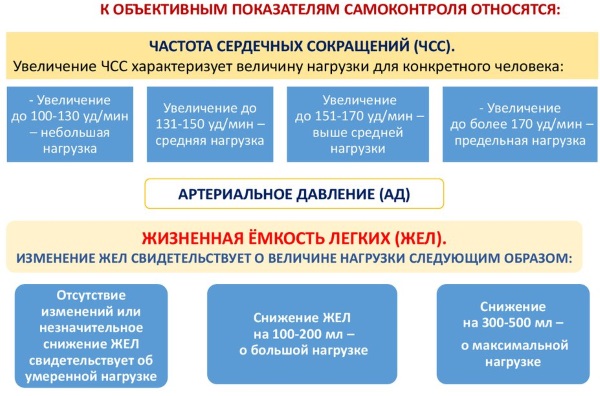
Sweating
This indicator depends, among other things, on many physiological processes of the body and is individual. Usually, the first workouts cause more profuse sweating, then its volume decreases.
It can be moderate, low, large, or profuse. It must be borne in mind that the volume of this indicator is influenced by the amount of liquid consumed during the day.
Blood pressure
Blood pressure, like heart rate, is measured at rest and after physical activity. Usually, after training, a decrease in pressure is recorded.that stabilizes within a few minutes. If this does not happen, you should consult a doctor. Also, medical supervision and recommendations are necessary for people suffering from hypertension or hypotonic disease.
Pulse
The determination of the pulse rate is carried out by checking the heart rate before and after physical activity, with the establishment of the percentage of their frequency. The indicators at rest should be taken as 100%, and the difference in frequency should be taken as the set value.
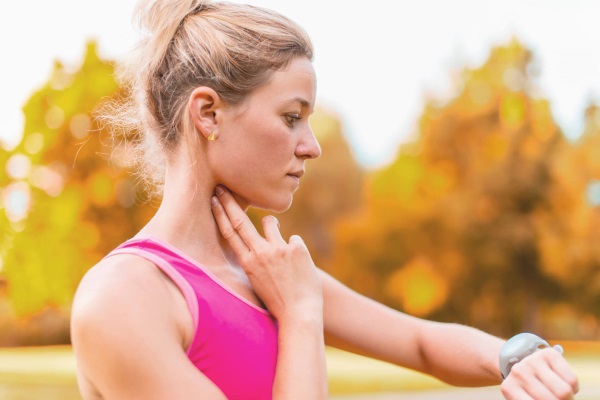
It should be borne in mind that this indicator in a person who regularly engages in physical activity (sports) at rest will be lower than that of a person who does not do it, and will return to normal faster after training. In addition to the frequency, you need to pay attention to the rhythm of the pulse. In particular, during physical exertion or overstrain, the pulse will be arrhythmic.
Body mass
Usually this indicator is measured 1-2 times a week. For professional athletes, in particular, in preparation for and during competitions, changes are made more often, since it is necessary to be in a certain weight category. The measurement is taken on an empty stomach, without clothes, in the morning.
If in the morning there is no opportunity to control weight, then this can be done at a different time, but it should always be the same. It is also important to use the same balance when measuring.
Various techniques are used to determine the optimal weight. For example, Broca's index, according to which body weight is the difference in body length in cm and one of the values (100/105/110), which is selected depending on a person's height.
Also used by the Ketl index, which determines the ratio of body weight in g to height in cm. Norm for men: 350 - 400 g / cm, for women: 325 - 375 g / cm.
It should be remembered that in order to maintain the optimal weight value, it is necessary to monitor the diet. The diet should definitely include fruits, vegetables, dairy products. The portions should be small, the number of meals per day: 4 - 5. In addition, the average values of the indicator depend on the height, age, gender and other data of the person.
VC indicator measurement (spirometry)
This method allows you to determine the maximum volume of air that a person's lungs can fill with a full inhalation. (vital capacity of the lungs). Measured with a spirometer. The values depend on the age, gender and condition of the person.
The average value for women is 3000 - 3500 cm³, for men 4000 - 4500 cm³. People who regularly engage in physical education (sports) have a volume of up to 7000 cm³.
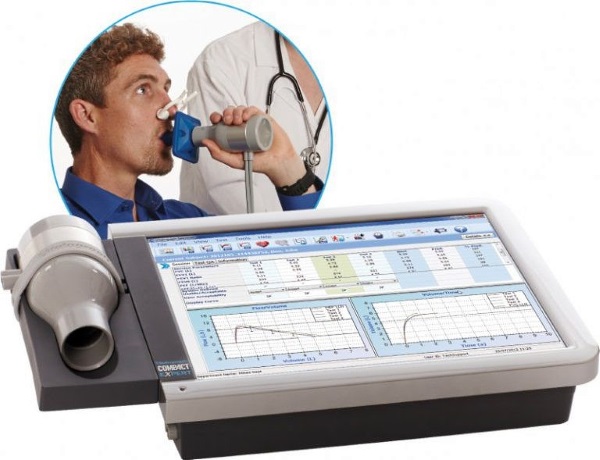
Measurement of static stability
The Romberg pose is used: feet together (possibly on 1 line, toe to heel), arms extended forward, fingers apart, eyes closed. The time of stability of this posture and the beginning of trembling of the hands is recorded. The less trained a person is, the less time he will be in this position will be stable.
Kersh step test
This method is used to determine the condition in women.
To complete it, you need to go up and down on a chair or bench for 4 counts with an interval of 5 seconds. for 2 accounts:
- once - put 1 leg on a bench (chair);
- two - the second leg is placed;
- three - 1 foot descends to the floor;
- four - the second leg descends.
Test duration - 3 minutes.
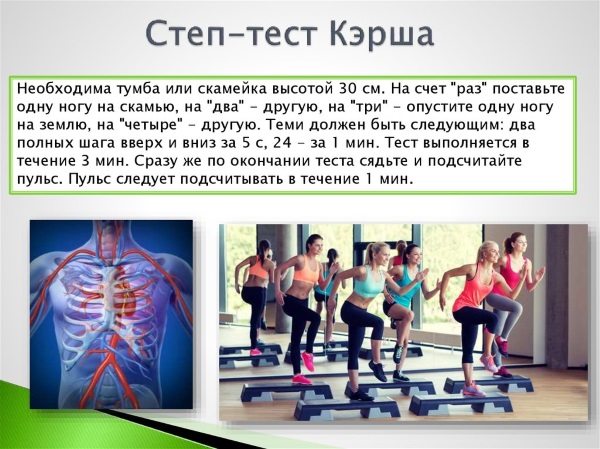
| Condition assessment | Heart rate (bpm) depending on age | |
| from 18 to 26 years old | from 27 to 60 years old | |
| Very bad | 115 | 122 |
| poorly | 108 – 114 | 113 – 121 |
| Mediocre | 101 — 107 | 104 – 112 |
| Satisfactorily | 91 – 100 | 93 – 103 |
| Good | 83 – 90 | 84 – 92 |
| Excellent | 74 – 82 | 75 – 83 |
| Excellent | 73 | 74 |
The recommended bench height when performing this test for a person up to 152 cm tall is 30 cm, for those who are taller, the height should be increased for every 7.5 cm in height - 5 additional cm of the bench (chair).
Stange test
It is used to determine the state of the cardiovascular and respiratory systems of the body.
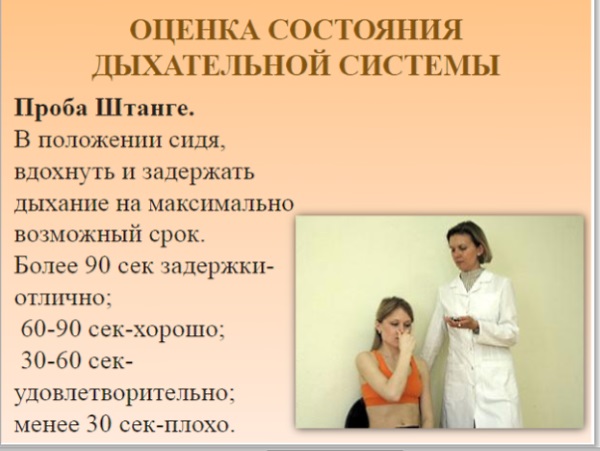
Genchi test
Another method based on holding the breath after full exhalation. The norm for this measurement is considered to be an indicator of 30 seconds.
Orthostatic test
Several variants of such a test are used. It allows you to establish how the cardiovascular system reacts to stress.
The most commonly used option is:
- rest in a supine position - 5 minutes;
- pulse rate measurement for 1 min .;
- rest while standing - 1 min;
- pulse rate measurement for 1 min.
Next, the difference in heart rate during rest in different positions is determined.
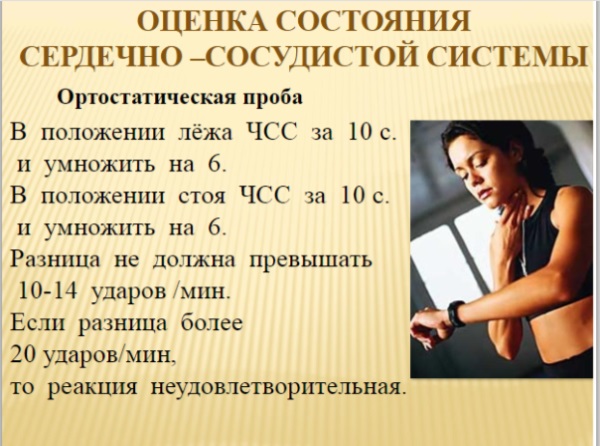
- satisfactory: 12 - 18;
- bad: 19 - 25;
- very bad: from 25.
Subjective indicators of the state of the body are also important.
Wellbeing
This is a generalized name for the psychophysical state of a person: the presence of any unpleasant sensations, their nature and localization, good or bad mood, cheerful state or lethargy, dizziness, and so on. In the aggregate of what a person feels, he determines for himself what state of health he has: bad, good or satisfactory.
It should be noted that the analysis of unpleasant (pain) sensations can be an indicator of both overload during exercise or overwork, and the presence of diseases or disorders in the work of an organ. In particular, if such signs are localized in the region of the heart, you should immediately consult a doctor.
Operability
An indicator influenced by the general condition of the body.
It happens:
- reduced;
- ordinary;
- increased.
One of the performance characteristics is the presence and degree of fatigue, that is, fatigue of a person, his desire to perform his usual functions or exercises. When fixing this indicator, if there are deviations from the usual state, their duration and accompanying factors should be noted. This will allow you to more objectively identify the cause and eliminate it.
Of course, mood also affects performance. So, a bad mood or a desire to be alone, entails a reduced degree of this indicator.
Sleep
For good health and performance, a sound, healthy sleep is necessary, which helps to restore the proper functioning of the human central nervous system. Abnormalities (insomnia, persistent drowsiness, or intermittent restless sleep) are usually signs of overwork.
Appetite
Like sleep, decreased or increased appetite indicates some abnormality in the state of the body. This can be due to both fatigue and some kind of illness.
Control by external and internal signs
Of course, this method is associated with subjective and objective indicators, since it analyzes sweating, shortness of breath, skin color, and respiratory rate. Attention is paid to the coordination of human movement.
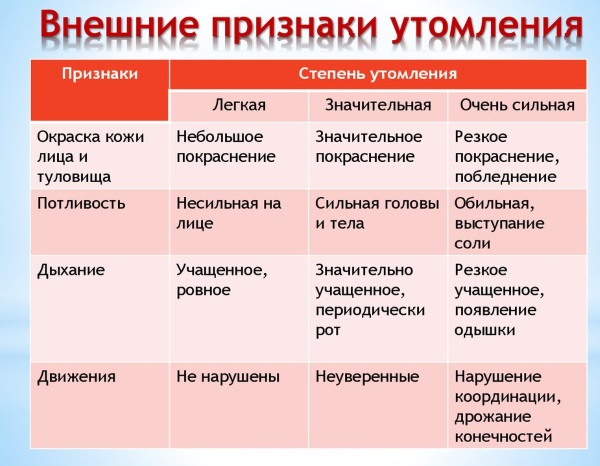
Keeping a diary
Self-control during exercise, including through the use of various methods, will be meaningless in the absence of a system for this control and data analysis.
Keeping a diary is important for self-control and obtaining correct recommendations for physical activity., which regularly reflects the indicators of the state of the body. In this case, both objective and subjective data are to be entered, as well as what classes were carried out.
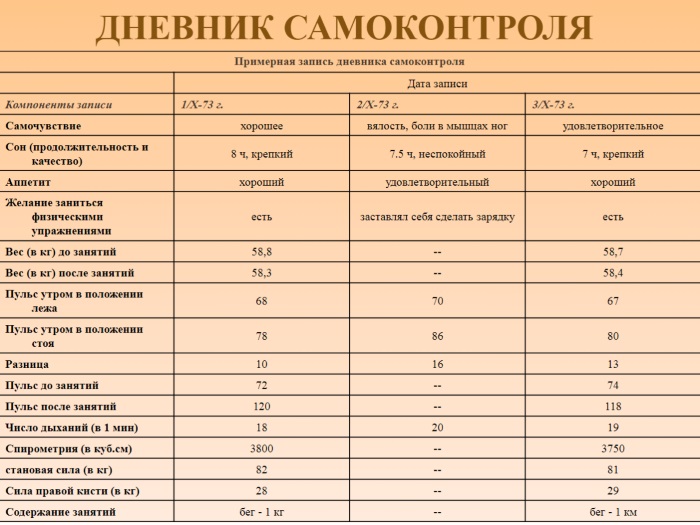
If something bothers you, you need to see a doctor and a trainer, who, based on the data displayed in the diary, will help identify the problem and work out ways to solve it.
The importance of self-control in human life is great. Control over emotions, reaction to certain influencing factors allows you to be more disciplined, rational, and successful. But the development and use of self-control skills must be carried out responsibly.
When engaging in physical exercises, it is necessary to remember not only that they should not be performed in the absence of a system and control, but also that independent control does not replace medical, and no less important, coaching.
Their combination will allow you to determine the most optimal training load.
Article author: Elena Doroshenko
Video on the topic: methods of control and self-control over the physical condition
Methods of control and self-control over the trainee's physical condition:

